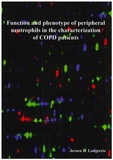Function and phenotype of peripheral neutrophils in the characterization of COPD patients

Langereis, Jeroen
- Promoter:
- Prof.dr L. (Leo) Koenderman & prof.dr J.W.J. (Jan Willem) Lammers
- Co-promoter:
- Dr L.H. (Laurien) Ulfman
- Research group:
- Koenderman
- Date:
- June 29, 2010
- Time:
- 16:15 h
Summary
COPD is a major health problem worldwide and is currently the third cause of morbidity and mortality in the European Union. COPD is a heterogeneous disease that is characterized by irreversible airflow limitation and parenchymal destruction. The severity of COPD is categorized in 5 stages as described by the Global Initiative on Obstructive Lung Disease (GOLD). The GOLD stages are depending on FEV1 (forced expiratory volume in 1 second), FEV1/FVC (forced vital capacity) and clinical symptoms such as cough, sputum production, dyspnoea or exposure to risk factors such as cigarette smoke. However, the GOLD criteria do not allow the characterization of systemic inflammation in COPD patients. Unbiased approaches, such as proteomics, are needed to identify novel biomarkers for systemic inflammation in COPD patients. Fluorescence two-dimensional difference gel electrophoresis (2D-DIGE) is a sensitive proteomics technique to identify protein differences. As proof of principle, we stimulated peripheral neutrophils with TNF? and GM-CSF in vitro and analyzed their protein content by 2D-DIGE to identify cytokine-specific profiles. Further studies focused on the function and phenotype of peripheral neutrophils in the characterization of COPD patients. We addressed three topics: 1) Protein expression profiles of peripheral neutrophils to characterize the systemic inflammatory response in COPD. We compared protein expression profiles of peripheral neutrophils from COPD patients and healthy control subject by 2D-DIGE. Differences in protein expression were used in a hierarchical clustering analysis to identify differences between healthy controls and COPD patients. We identified at least two groups of COPD patients, who showed no significant differences in lung function, but showed differences in stimulus-induced integrin activation. This illustrates the existence of important differences in systemic inflammation in COPD patients, which do not correlate to the current COPD characterization. Among the proteins differentially expressed between healthy controls and COPD patients, we found increased expression of high molecular weight complexes of annexin A1 on neutrophils from COPD patients. Expression of high molecular weight annexin A1 might be an interesting marker for systemic inflammation in COPD. 2) The effects of glucocorticosteroids on neutrophils in vitro to study mechanisms that might underlie the poor efficacy of this treatment in COPD. Glucocorticosteroids inhibited synthesis and secretion of sIL-1Ra at lower concentrations compared to IL-1?, which changed the IL-1?: sIL-1Ra ratio significantly. In vivo, moderate–to-severe COPD patients using inhaled glucocorticosteroids showed decreased plasma sIL-Ra levels compared to mild-to-moderate patients that were not on glucocorticosteroid treatment. Furthermore, inhibition of NF-?B by glucocorticosteroids or other inhibitor induced neutrophils survival. These results might explain the poor efficacy of glucocorticosteroids in COPD. 3) The underlying mechanisms controlling integrin functionality on leukocytes. We compared suspension and adherent variants of a mouse acute lymphocytic leukemia cell by 2D-DIGE and identified gelsolin to be increased in adhering cells. Overexpression of gelsolin in a suspension U937 cell line resulted in increased high affinity integrin expression and cell adhesion. The expression of gelsolin correlated with the expression of talin, which could function as the regulator in integrin affinity.